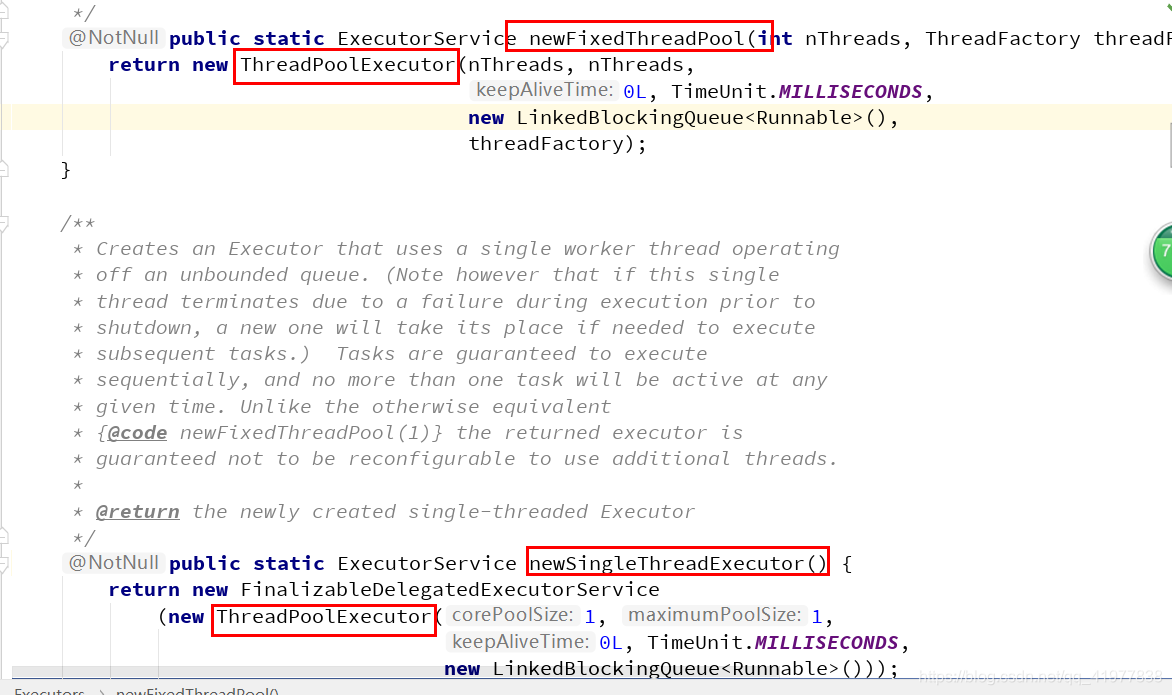线程池原理剖析

我们每一个线程池 都会 nwe ThreadPoolExecutor 类 会传入几个参数

corePoolSize: 核心池的大小。 当有任务来之后,就会创建一个线程去执行任务,当线程池中的线程数目达到corePoolSize后,就会把到达的任务放到缓存队列当中
maximumPoolSize: 线程池最大线程数,它表示在线程池中最多能创建多少个线程;
keepAliveTime: 表示线程没有任务执行时最多保持多久时间会终止。
unit: 参数keepAliveTime的时间单位
所以我们基本了解线程池的实现
corePoolSize 与 maximumPoolSize 的区别:
corePoolSize :实际运用的线程数,
maximumPoolSize :线程池最多创建多少个线程
为什么要这么设计呢 有了最大线程数,为什么要设计核心池大小呢
- 如果线程数小雨corePoolSize , 其他线程就会使用线程池来执行任务
- 如果线程数等于(或大于)corePoolSize 但少于 核心池大小,折将任务放入队列 (阻塞或非阻塞队列)
- 如果队列已满,线程数小于maximumPoolSize, 则常见一个新线程来执行任务,
- 如果线程数已满,并且线程数大于等于 核心池大小,则拒绝该任务
执行线程池源码实现就如我们上面的讲解
/**
* Executes the given task sometime in the future. The task
* may execute in a new thread or in an existing pooled thread.
*
* If the task cannot be submitted for execution, either because this
* executor has been shutdown or because its capacity has been reached,
* the task is handled by the current {@code RejectedExecutionHandler}.
*
* @param command the task to execute
* @throws RejectedExecutionException at discretion of
* {@code RejectedExecutionHandler}, if the task
* cannot be accepted for execution
* @throws NullPointerException if {@code command} is null
*/
public void execute(Runnable command) {
if (command == null)
throw new NullPointerException();
/*
* Proceed in 3 steps:
*
* 1. If fewer than corePoolSize threads are running, try to
* start a new thread with the given command as its first
* task. The call to addWorker atomically checks runState and
* workerCount, and so prevents false alarms that would add
* threads when it shouldn't, by returning false.
*
* 2. If a task can be successfully queued, then we still need
* to double-check whether we should have added a thread
* (because existing ones died since last checking) or that
* the pool shut down since entry into this method. So we
* recheck state and if necessary roll back the enqueuing if
* stopped, or start a new thread if there are none.
*
* 3. If we cannot queue task, then we try to add a new
* thread. If it fails, we know we are shut down or saturated
* and so reject the task.
*/
int c = ctl.get();
if (workerCountOf(c) < corePoolSize) {
if (addWorker(command, true))
return;
c = ctl.get();
}
if (isRunning(c) && workQueue.offer(command)) {
int recheck = ctl.get();
if (! isRunning(recheck) && remove(command))
reject(command);
else if (workerCountOf(recheck) == 0)
addWorker(null, false);
}
else if (!addWorker(command, false))
reject(command);
}
提交一个任务到线程池中,线程池的处理流程
1、判断线程池里的核心线程是否都在执行任务,如果不是(核心线程空闲或者还有核心线程没有被创建)则创建一个新的工作线程来执行任务。如果核心线程都在执行任务,则进入下个流程。
2、线程池判断工作队列是否已满,如果工作队列没有满,则将新提交的任务存储在这个工作队列里。如果工作队列满了,则进入下个流程。
3、判断线程池里的线程是否都处于工作状态,如果没有,则创建一个新的工作线程来执行任务。如果已经满了,则交给饱和策略来处理这个任务。
